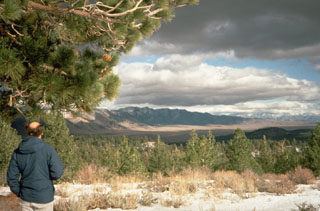Report on Long Valley (United States) — December 1989
Scientific Event Alert Network Bulletin, vol. 14, no. 12 (December 1989)
Managing Editor: Lindsay McClelland.
Long Valley (United States) Seismicity increases in caldera's S moat
Please cite this report as:
Global Volcanism Program, 1989. Report on Long Valley (United States) (McClelland, L., ed.). Scientific Event Alert Network Bulletin, 14:12. Smithsonian Institution. https://doi.org/10.5479/si.GVP.SEAN198912-323822
Long Valley
United States
37.7°N, 118.87°W; summit elev. 3390 m
All times are local (unless otherwise noted)
The seismic swarm ... declined significantly from October through December. Meanwhile, a few earthquakes began in October around the S margin of the resurgent dome, which has been relatively inactive for several years. A distinct increase in seismicity began there in November. A burst of 40 events was recorded 5 January in the S moat area, followed by fluctuating activity; some days were seismically quiet. Seismicity appeared similar in many ways to that of the early 1980's, although more of the current activity occurred on the W side of the resurgent dome than previously. Focal depths, generally ~6-10 km, also resembled those of the early 1980's, with the deeper events on the E side of the epicentral zone. Some shocks on the W side of the resurgent dome were <4 km deep. The rate of extension across the resurgent dome began to increase in mid-1989, reaching ~5 microstrain/year by December. This is ~5 times the rate seen in recent years.
Geological Summary. The large 17 x 32 km Long Valley caldera east of the central Sierra Nevada Range formed as a result of the voluminous Bishop Tuff eruption about 760,000 years ago. Resurgent doming in the central part of the caldera occurred shortly afterwards, followed by rhyolitic eruptions from the caldera moat and the eruption of rhyodacite from outer ring fracture vents, ending about 50,000 years ago. During early resurgent doming the caldera was filled with a large lake that left strandlines on the caldera walls and the resurgent dome island; the lake eventually drained through the Owens River Gorge. The caldera remains thermally active, with many hot springs and fumaroles, and has had significant deformation, seismicity, and other unrest in recent years. The late-Pleistocene to Holocene Inyo Craters cut the NW topographic rim of the caldera, and along with Mammoth Mountain on the SW topographic rim, are west of the structural caldera and are chemically and tectonically distinct from the Long Valley magmatic system.
Information Contacts: D. Hill, USGS Menlo Park.

